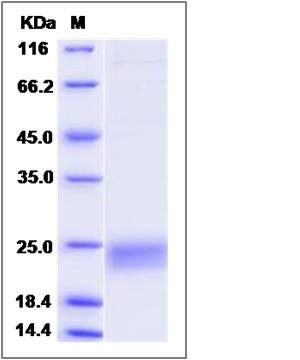Human BTC / Betacellulin Protein
BTC
- 100ug (NPP1089) Please inquiry
| Catalog Number | P12192-HCCH |
|---|---|
| Organism Species | Human |
| Host | Human Cells |
| Synonyms | BTC |
| Molecular Weight | The recombinant human BTC comprises 87 amino acids and has a predicted molecular mass of 9.8 kDa. The apparent molecular mass of the protein is approximately 24 kDa in SDS-PAGE under reducing conditions. |
| predicted N | Asp 32 |
| SDS-PAGE |  |
| Purity | > 90 % as determined by SDS-PAGE |
| Protein Construction | A DNA sequence encoding the human BTC (P35070) (Met1-Tyr111) was expressed with six amino acids (LEVLFQ) at the C-terminus. |
| Bio-activity | Measured in a cell proliferation assay using Balb/3T3 mouse embryonic fibroblast cells. The ED50 for this effect is typically 0.2-1 ng/mL. |
| Research Area | Cancer |Invasion microenvironment |Angiogenesis |Growth Factor & Receptor |Epidermal Growth Factor (EGF) & Receptor |Epidermal Growth Factor (EGF) | |
| Formulation | Lyophilized from sterile PBS, pH 7.4. 1. Normally 5 % - 8 % trehalose and mannitol are added as protectants before lyophilization. Specific concentrations are included in the hardcopy of COA. |
| Background | Betacellulin(BTC) is a member of the epidermal growth factor (EGF) family. These soluble proteins are ligands for one or more of the four receptor tyrosine kinases encoded by the ErbB gene family (ErbB-1/epidermal growth factor receptor (EGFR), neu/ErbB-2/HER2, ErbB-3/HER3 and ErbB-4/HER4). Betacellulin is a 32-kilodalton glycoprotein that appears to be processed from a larger transmembrane precursor by proteolytic cleavage. This protein is a ligand for the EGF receptor. BTC is a polymer of about 62-111 amino acid residues. Secondary Structure: 6% helical (1 helices; 3 residues)36% beta sheet (5 strands; 18 residues). BTC was originally identified as a growth-promoting factor in mouse pancreatic β-cell carcinoma cell line and has since been identified in humans. It plays a role in the growth and development of the neonate and/or mammary gland function. Betacellulin is a potent mitogen for retinal pigment epithelial cells and vascular smooth muscle cells. |
| Reference |
